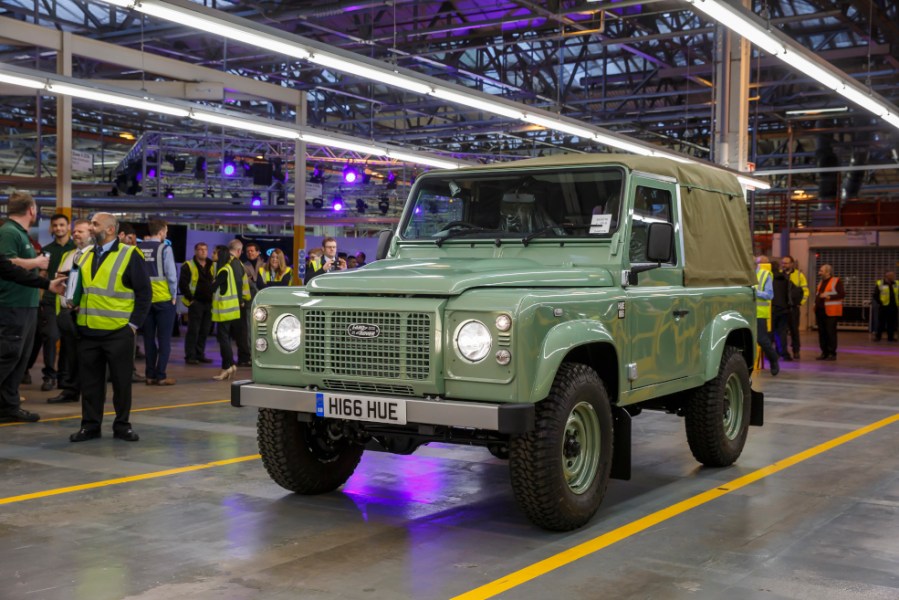With Defender about to become a marque in its own right, we chart the history of the modern Land Rover
Words: Paul Wager Images: Land Rover
The modern history of Jaguar Land Rover – or JLR as it likes to be known now – is founded on the success of the Land Rover brand while Jaguar struggles to find its place in the modern automotive landscape and is effectively taking a break while its new EV future takes shape.
In fact, so successful is the Land Rover part of the business that the firm is planning to let the Land Rover marque itself take a back seat while the individual model lines – Discovery, Range Rover and Defender – become marques in their own right.
To anyone who can remember the Land Rover of the mid-80s, this all seems rather curious since the Defender tag itself is actually a pretty youthful one – in fact, it’s a year younger than Toyota’s upstart Lexus brand.
Ultimately, the history of the Defender badge actually begins with the rise of Japanese leisure-orientated 4x4s that had Land Rover on the back foot, like the Mitsubishi Shogun. After a belated flurry of investment, the Range Rover had started to head ever more upmarket and was now out of reach for the buyers who wanted a true dual-purpose vehicle.
Meanwhile, the original Land Rover was looking increasingly agricultural as an everyday family vehicle, meaning the company desperately needed something to fill the mid-range spot.
The answer of course was to stick a modern seven-seater body on the Range Rover chassis to create the Discovery. It was one of those brilliant bits of lateral thinking that the British motor industry has historically been so good at when the chips are down and budgets are tight. The Land Rover Discovery proved to be a runaway success.
It did however create a new problem; one of badging. Using Land Rover as a marque meant that in theory the range would now include a ‘Land Rover Land Rover’ and so a new name was required for the original.
It would in fact be the second name change for the vehicle in just a few years, since the addition of coil springs, permanent four-wheel drive and five-speed gearbox in 1983 had seen the original Land Rover renamed as Land Rover 90, Land Rover 110 and the extended-chassis Land Rover 127, the number signifying wheelbase length in inches.
It was hardly snappy though, and after some deliberation – and negotiations with another car maker with rights to the name – the Defender name was chosen. The word had already been used internally as a project name but was also a perfect choice to symbolise the vehicle’s rugged nature and its historical association with the military.

Early Defender was essentially a renamed 90/110
Despite the new name, the vehicle was very little changed from the existing 90 and 110 models which alongside the revised suspension had introduced a modernised interior and enlarged windscreen, although the 127-inch model was rounded up to 130.
The big news though was the addition of the newly developed 200TDi engine, an in-house development by Land Rover that was essentially a modernised, intercooled and direct-injected version of the old turbodiesel engine. With 107bhp and 195lb ft torque, the new engine at last allowed a decent cruising speed and acceptable economy, although the petrol V8 remained as a special order option and in theory the venerable 2.5-litre petrol was also available, although in reality most UK buyers went for the new diesel.
In 1994, the 200TDi was uprated to become the 300TDi, an extensive redesign of the 200TDi unit that left very few components unchanged including the block and head. In fact, Land Rover insiders point out that the name ‘300’ refers to the number of new components in the design.
Although power outputs were unchanged, the 300TDi was more refined and specifically designed to fit Range Rover, Discovery and Defender, as well as to accommodate a 24-volt alternator for the military, which had been using the old 2.5 diesel for that reason. It was also developed with an eye to forthcoming emissions regulations that the 200 was unable to meet. The LT77 manual gearbox was replaced by the R380 at the same time.
It was destined to be short-lived however, as an all-new Land Rover engine would appear in 1998 as the Td5. Another in-house Land Rover development, the straight-five engine imparted a Quattro-like soundtrack to Discovery and Defender alongside much improved power. For retail buyers, the Td5 replaced the 300TDi, although concern over its electronic engine management saw the 300 remain as a special order option for military vehicles. Similarly the Rover V8 was also available as a special order for utility vehicles needing more power.
In 2001, a much-needed facelift took place, introducing a revised dashboard and options like heated seats and electric windows, something which was made possible by tighter production tolerances (reduced from 6.5mm to 0.2mm) and galvanised steel doors. The luxury XS specification was added, while the County trim option was extended across the range.

Fitting the Ford ‘Puma’ engine and better heater in 2006 meant the scuttle vents were blanked off
In April 2006, a bigger change came with the replacement of the Td5 engine by the 2.4-litre four-cylinder ‘Puma’ diesel engine provided by new parent company Ford. Driving through a six-speed Getrag MT82 gearbox, the new engine lacked the characterful warble of the five-pot but introduced more power, economy and refinement.
The Puma-engined Land Rovers are easily identified by their humped bonnet, required to clear the taller Ford engine which would otherwise have required a costly redesign of the sump to allow for front axle articulation. The raised engine position also required a revised floor pressing to accommodate the gearbox, while alterations to the radiator positioning meant it was forward of the headlamps.
Alongside exhaust emissions regulations came more stringent drive-by noise restrictions, which Land Rover achieved by sealing the engine area, something which apparently made the horn inaudible. This in turn was solved by pressing three vents into the headlamp surround.

New full-width dashboard from 2006 used an unlikely mixture of Discovery 3 and Transit parts
Major changes were also made to the interior, with a proper dashboard appearing for the first time. This used an unlikely combination of Discovery 3 and Transit parts but made a big difference to the interior ambience, even if the Metro column stalks and Marina ignition switch were retained. A revised heating and ventilation system was also installed which was vastly more efficient than the primitive set-up previously used, able the heat the interior 40 per cent faster and achieve cabin temperatures 12°C higher. It also rendered the signature flaps below the screen redundant. Curiously, although the bulkhead pressing was amended to remove the opening flaps, their outline remained.
Perhaps the biggest change however was to the seating layout. EU regulations had outlawed the sideways-facing seats, which had enabled the 90-inch Land Rover to carry seven people and made the 110-inch model a nine-seater. Instead, a conventional two-row layout was employed for the 90 and a three-row layout in the 110; without the front bench seat this reduced the Land Rovers to four-seater status in 90-inch form or seven-seater as 110.
The 2007 changes also introduced a ‘Utility Pack’ as a no-cost option on the 110 Station Wagon, removing the third row of seats and replacing the side windows with panels to create a van-style five-seater utility vehicle.
By 2012, Land Rover was publicly admitting that increasingly stringent safety and emissions regulations on the horizon would mean the original Defender’s days were numbered, but so successful were the previous upgrades that sales were still strong enough at 25,000 a year to justify a further round of upgrades.

The final Defender left the line on January 29, 2016
This meant the replacement of the 2.4 engine in 2011 for the 2012 model year by a 2.2-litre Duratorq engine, which could meet Euro 5 regulations using a particulate filter and produced the same power and torque. The Defender could also now be ordered with a Comfort Pack including air conditioning, electric windows and remote locking, as well as an off-road pack including ABS, heavy-duty wheels and tyres, plus a towbar.
By now the Defender had taken on a newfound lifestyle appeal and to accommodate this, Land Rover reintroduced the canvas-topped model that had been popular with the Series models but which had been a special-order model only.
This would be the last major change to the Defender, with production finally ending on Friday, January 29, 2016, after a last-minute extension to meet demand. During its 68-year production life, over two million examples were built, with 75% of them reckoned still to be on the road.
















